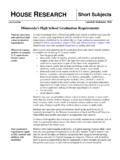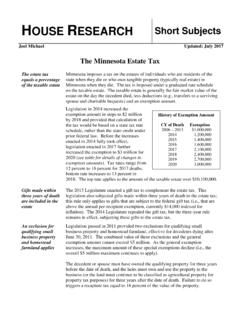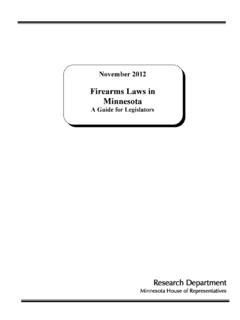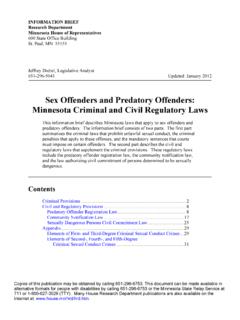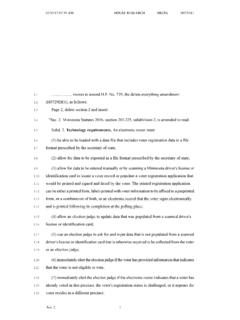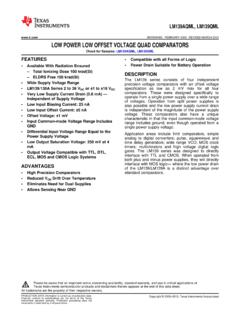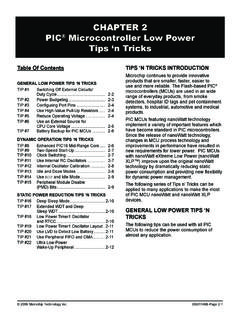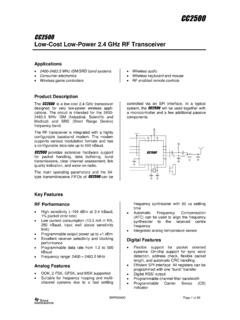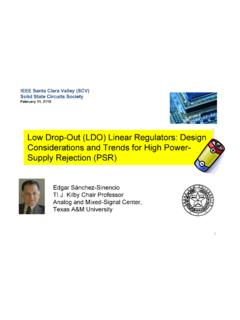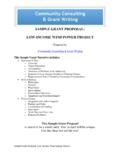Transcription of Low-Power and Unconventional Vehicles
1 Copies of this publication are available by calling 651-296-6753. This document can be made available in alternative formats for people with disabilities by calling 651-296-6753 (voice) or the Minnesota State Relay Service at 711 or 1-800-627-3529 (TTY) for assistance. Many House Research Department publications are also available on the Internet at: INFORMATION BRIEF Research Department Minnesota House of Representatives 600 State Office Building St. Paul, MN 55155 Matt Burress, Legislative Analyst Updated: February 2018 Low-Power and Unconventional Vehicles The types of motorized Vehicles available in Minnesota have continued to expand. Low-Power and Unconventional Vehicles include autocycles, e-bikes, mini-trucks, motor scooters, motorized foot scooters, and neighborhood electric Vehicles .
2 They range from small recreational devices intended mainly for children to on-road Vehicles that can match the power and performance of passenger autos. This information brief describes the various types of Vehicles , outlining their classification and basic regulation under Minnesota law. Table of Contents Executive Summary ..2 Regulation Summary Tables ..3 Identifying the Vehicle Classification ..6 Vehicle Descriptions and Key Regulations ..6 All-Terrain Vehicles and Utility Task Vehicles ..7 Electric-Assisted Bicycles ..12 Golf Carts ..14 Mini-trucks ..16 Motor Scooters and Motorcycles ..18 Motorized Bicycles (Mopeds)..20 Motorized Foot Scooters ..22 Neighborhood Electric Vehicles and Medium-Speed Electric Vehicles ..24 Pocket Segways and Self-Balancing Scooters.
3 28 House Research Department Updated: February 2018 Low-Power and Unconventional Vehicles Page 2 Executive Summary This information brief summarizes lower- power vehicle laws in Minnesota. As the term is used here, Low-Power and Unconventional Vehicles include autocycles, all-terrain Vehicles , electric-assisted bicycles, golf carts, mini-trucks, motor scooters, motorized foot scooters, motorized bicycles (or mopeds), and neighborhood electric Vehicles . Although the Vehicles are all motorized they vary greatly in form, size, features, and intended use. In most cases the Vehicles are smaller and less powerful than a typical car, truck, or SUV. Some are essentially devices marketed mainly to children, whereas others represent an alternative to driving a standard passenger automobile.
4 Minnesota law regulates vehicle operation on public streets and highways and establishes licensing, insurance, and equipment requirements. Legislation in recent years has established new classifications of Vehicles and devices and, in many cases, specific regulations for each type of vehicle. The expansion in vehicle categories defined in law reflects a rise in the variety of Vehicles now available to consumers. House Research Department Updated: February 2018 Low-Power and Unconventional Vehicles Page 3 Regulation Summary Tables The tables below outline basic requirements for each type of vehicle. Subsequent sections provide descriptions and more detail on regulations for each vehicle classification. All- Terrain Vehicle and Utility Task Vehicle Autocycle Electric-Assisted Bicycle Example Legal attributes ATV: up to 960 cc engine, three to six flotation tires, max.
5 1,800 lbs. dry weight UTV: four wheels, up to 1,200 cc engine, 1,800 to 2,600 lbs. dry weight Three wheels, nonstraddled seats, steering wheel, anti-lock brakes, meets federal safety standards for motorcycle Bicycle with saddle, pedals for human propulsion, two to three wheels, max. 1,000-watt electric motor, 20 top speed, meets federal standards Registration Local special permit; typically DNR registration for ATV use Title, vehicle registration, tax, license plate None required Operator licensing None required Driver s license (no endorsement needed) None required; minimum operator age is 15 Insurance Liability coverage (same as passenger autos) Liability coverage (same as passenger autos) None required Operating rules Generally same traffic laws as other motor Vehicles ; some limitations on operating at night and in low visibility Generally same traffic laws as other motor Vehicles ; various limitations Generally same traffic laws as motor Vehicles ; various limitations Safety equipment Most equipment laws do not apply.
6 Rearview mirror Helmet if under age 18 and cabin is unenclosed; various equipment requirements; headlight on at all times Certain lighting generally required for night; helmet not required Notes ATV refers to an all-terrain vehicle. UTV refers to a utility task vehicle. DNR refers to the Department of Natural Resources. House Research Department Updated: February 2018 Low-Power and Unconventional Vehicles Page 4 Golf Cart Mini-truck Motor Scooter and Motorcycle Example Legal attributes Not specifically defined in law Up to 660 cc or 7,500-watt engine, 900 to 2,200 lbs. dry weight, does not meet certain federal safety standards Motor scooter: not specifically defined in law Motorcycle: seat or saddle, up to three wheels Registration Local special permit Local special permit; possible DNR registration as ATV Title, vehicle registration, tax, license plate Operator licensing None required Driver s license or permit Driver s license with two-wheeled vehicle endorsement Insurance Liability coverage (same as passenger autos) Liability coverage (same as passenger autos) Liability coverage (same as passenger autos) Operating rules Generally same traffic laws as other motor Vehicles .
7 Some limitations on operating at night and in low visibility Generally same traffic laws as other motor Vehicles Generally same traffic laws as other motor Vehicles ; various limitations; no operation on sidewalks Safety equipment Most equipment laws do not apply; rearview mirror; slow-moving vehicle emblem Headlights; taillights; turn signals; mirrors; windshield; seat belt; parking brake Helmet if under age 18; various equipment requirements; eye protection for all operators; headlight on at all times Notes ATV refers to an all-terrain vehicle. UTV refers to a utility task vehicle. DNR refers to the Department of Natural Resources. House Research Department Updated: February 2018 Low-Power and Unconventional Vehicles Page 5 Motorized Bicycle Motorized FootScooter Electric Vehicles Segway and Self-Balancing Scooter Example Legal attributes Up to 50 cc and 2 HP engine, 30 top speed Handlebars, motor, max.
8 12-inch wheels, 15 top speed NEV: electric motor, three to four wheels, 20 to 25 top speed MSEV: electric motor, misc. equipment, 35 top speed Electric motor, two nontandem wheels, designed for one person, 15 top speed Registration Title, vehicle registration, tax, license plate None required Title, vehicle registration, tax, license plate None required Operator licensing Driver s license or operator s permit None required; minimum operator age is 12 Driver s license or permit None required Insurance Liability coverage (same as passenger autos) None required Liability and personal injury coverage (same as passenger autos) None required Operating rules Generally same traffic laws as motorcycles and other motor Vehicles ; various limitations; no operation on sidewalks Generally same traffic laws as bicycles; no operation on sidewalks.
9 Allowed on certain bike paths and trails Generally same traffic laws as other motor Vehicles ; no operation on roads with speed limit above 35 Generally same traffic laws as pedestrians; allowed on bike paths Safety equipment Helmet if under age 18; eye protection; certain lighting generally required for night; if so equipped, headlight on at all times Helmet if under age 18; headlight and reflector required for night Must meet federal equipment requirements Reflectors required Notes NEV refers to a neighborhood electric vehicle. MSEV refers to a medium-speed electric vehicle. House Research Department Updated: February 2018 Low-Power and Unconventional Vehicles Page 6 Identifying the Vehicle Classification Due to the wide variety of Low-Power and Unconventional Vehicles that are now on the market, it can be challenging to determine how a specific make and model in a particular year is classified under Minnesota law.
10 In particular, autocycles, motor scooters, motorized bicycles, and motorcycles have many similarities. Because state regulation varies with each vehicle, a key question is whether the vehicle in question fits one of the legal definitions established in Minnesota Statutes. See Minn. Stat. The specific characteristics of a particular vehicle determine its classification. Although other features are relevant, engine size is a key factor in identifying scooters, mopeds, and motorcycles under Minnesota law. Top speed, vehicle weight, and safety equipment are also important characteristics. A vehicle that has two or three wheels and does not clearly fit another vehicle definition is most likely classified as a motorcycle (even though it might not be considered one in the traditional sense).

